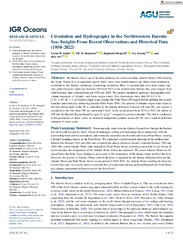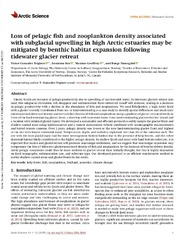Artikler, rapporter og annet (arktisk og marin biologi): Nye registreringer
Viser treff 21-40 av 1643
-
Circulation and Hydrography in the Northwestern Barents Sea: Insights From Recent Observations and Historical Data (1950–2022)
(Journal article; Tidsskriftartikkel; Peer reviewed, 2024-08-13)The Barents Sea is one of the main pathways for warm and saline Atlantic Water (AW) entering the Arctic Ocean. It is an important region where water mass transformation and dense-water production contribute to the Atlantic meridional overturning circulation. Here, we present data from three cruises and nine glider missions conducted between 2019 and 2022 in the northwestern Barents Sea, and compare ... -
Accuracy of serological tests for bovine brucellosis: A systematic review and meta-analysis
(Journal article; Tidsskriftartikkel; Peer reviewed, 2023-11-21)The direct methods for diagnosis of bovine brucellosis have several limitations, therefore serological tests are the basis for the diagnosis of the disease. However, a meta-analysis estimating the diagnostic sensitivity (DSe) and diagnostic specificity (DSp) on the main tests used in bovine brucellosis control programs worldwide has not been performed. This systematic review and meta-analysis aimed ... -
Households neighboring wildlife protected areas may be at a higher risk of rabies than those located further away: a community-based cross-sectional cohort study at Pian Upe game reserve, Bukedea district, Eastern Uganda
(Journal article; Tidsskriftartikkel; Peer reviewed, 2024-04-22)Introduction: This study examines rabies incidence and associated risk factors at the interface between wildlife and human communities near Pian-Upe game reserve in Eastern Uganda. We hypothesized that human settlements in closer proximity to the reserve would exhibit higher rabies risk compared to those located further away.<p> <p>Methods: Using a standard questionnaire, households within <4, ... -
Differences in Tri-Trophic Community Responses to Temperature-Dependent Vital Rates, Thermal Niche Mismatches and Temperature-Size Rule
(Journal article; Tidsskriftartikkel; Peer reviewed, 2024-12-02)Warming climate impacts aquatic ectotherms by changes in individual vital rates and declines in body size, a phenomenon known as the temperature-size rule (TSR), and indirectly through altered species interactions and environmental feedbacks. The relative importance of these effects in shaping community responses to environmental change is incompletely understood. We employ a tri-trophic food ... -
Growth and maturation of rainbow smelt (Osmerus mordax) at the northern limit of their distribution range (Lake Melville, Labrador): Support for the hypothesized temperature-size rule
(Journal article; Tidsskriftartikkel; Peer reviewed, 2024-12-06)Rainbow smelt (Osmerus mordax), a small pelagic fish found throughout the northwest Atlantic Ocean, experienced a northward retreat of its distribution range over the 20th century and an overall decline in biomass in recent decades, both attributed to warming waters and habitat loss. In the Lake Melville estuary (Labrador, Canada), at the northern limit of its distribution range, smelt represents ... -
A food-web assessment model for marine mammals, fish, and fisheries in the Norwegian and Barents Seas
(Journal article; Tidsskriftartikkel; Peer reviewed, 2024-10-15)The Norwegian and Barents Seas host large commercial fish populations that interact with each other, as well as marine mammal populations that feed on plankton and fish. Quantifying the past dynamics of these interacting species, and of the associated fisheries in the Norwegian and Barents Sea is of high relevance to support ecosystem-based management. The purpose of this work is to develop a food-web ... -
Synergy and competition during the anaerobic degradation of N-acetylglucosamine in a methane-emitting, subarctic, pH-neutral fen
(Journal article; Tidsskriftartikkel; Peer reviewed, 2024-12-11)Peatlands are invaluable but threatened ecosystems that store huge amounts of organic carbon globally and emit the greenhouse gasses carbon dioxide (CO<sub>2</sub>) and methane (CH<sub>4</sub>). Trophic interactions of microbial groups essential for methanogenesis are poorly understood in such systems, despite their importance. Thus, the present study aimed at unraveling trophic interactions between ... -
Seroprevalence and risk factors of brucellosis in pastoralists and their livestock in Central Equatoria State, South Sudan
(Journal article; Tidsskriftartikkel; Peer reviewed, 2024-12-19)Background Brucellosis poses serious public health implications and substantial economic losses in pastoral rural settings in South Sudan. In humans, brucellosis is almost always originating from animals. Current literature provides scant data regarding the seroprevalence of brucellosis in South Sudan. This cross-sectional study investigates the seroprevalence of brucellosis among the pastoral ... -
Contrasting two major Arctic coastal polynyas: the role of sea ice in driving diel vertical migrations of zooplankton in the Laptev and Beaufort seas
(Journal article; Tidsskriftartikkel; Peer reviewed, 2024-12-17)The diel vertical migration (DVM) of zooplankton is one of the largest species migrations to occur globally and is a key driver of regional ecosystems and the marine carbon pump. Previously thought to be hampered by the extreme light regime prevailing in the Arctic Ocean, observations have revealed that DVM does occur in ice-covered Arctic waters and suggest the decline in Arctic sea ice may thereby ... -
Seasonal changes in the feeding aggregation structure of male sperm whales (Physeter macrocephalus) in Northern Norway
(Journal article; Tidsskriftartikkel; Peer reviewed, 2024-12-25)The sperm whale (Physeter macrocephalus) is one of the most widely distributed cetaceans. Adult males commonly occupy high latitudes, whereas females and juveniles occupy lower latitudes. In Northern Norway, previous studies focused on the summer period limiting our understanding of the seasonal dynamics of male foraging aggregations. We used year-round capture–mark–recapture data based on photo ... -
Takvatnprosjektet – vellykket samarbeid mellom forskere og fiskeentusiaster
(Journal article; Tidsskriftartikkel; Peer reviewed, 2024)Overbefolka fiskebestander er et stort problem i mange innsjøer, særlig for røye, ørret, abbor og sik. Kjennetegnet er småvokst og mager fisk, gjerne med høy infeksjon av parasitter. Som et potensielt botemiddel ble et storstilt uttynningsfiske med teiner iverksatt i Takvatn (15 km2), Troms, på 1980-tallet. I nært samarbeid mellom forskere, grunneiere og fiskere ble 700.000 smårøye (31.3 tonn) tatt ... -
Extreme mismatch between phytoplankton and grazers during Arctic spring blooms and consequences for the pelagic food-web
(Journal article; Tidsskriftartikkel; Peer reviewed, 2024-10-13)Food-web structure determines the cycling pathways and fate of new production in marine ecosystems. Herbivorous zooplankton populations are usually seasonally coupled with pelagic primary producers. Synchrony of phytoplankton blooms with reproduction, recruitment and seasonal ascent of their main grazers ensures efficient transfer of organic carbon to higher trophic levels, including commercially ... -
One organ to infect them all: the Cuscuta haustorium
(Journal article; Tidsskriftartikkel; Peer reviewed, 2024-12-02)Background - Research on the parasitic plant genus Cuscuta has flourished since the genomes of several of its species were published. Most of the research revolves around the iconic infection organ that secures the parasite’s sustenance: the haustorium. Interest in understanding the structure–function–regulation relationship of the haustorium is based as much on the wish to find ways to keep the ... -
Macroecological patterns of rodent population dynamics shaped by bioclimatic gradients
(Journal article; Tidsskriftartikkel; Peer reviewed, 2024-12-27)Long-term studies of cyclic rodent populations have contributed fundamentally to the development of population ecology. Pioneering rodent studies have shown macroecological patterns of population dynamics in relation to latitude and have inspired similar studies in several other taxa. Nevertheless, such studies have not been able to disentangle the role of different environmental variables in shaping ... -
Goose grubbing and warming suppress summer net ecosystem CO2 uptake differentially across high-Arctic tundra habitats
(Journal article; Tidsskriftartikkel; Peer reviewed, 2024-12-09)Environmental changes, such as climate warming and higher herbivory pressure, are altering the carbon balance of Arctic ecosystems; yet, how these drivers modify the carbon balance among different habitats remains uncertain. This hampers our ability to predict changes in the carbon sink strength of tundra ecosystems. We investigated how spring goose grubbing and summer warming—two key environmental-change ... -
Hydrochemical characterization and sustainability assessment of Ismailia canal water, Eastern Nile Delta, Egypt: implications for human health and environmental safety
(Journal article; Tidsskriftartikkel; Peer reviewed, 2024-11-11)Surface freshwater systems globally face severe stresses due to overpopulation and associated waste. The Ismailia Canal, a crucial freshwater source in the eastern Nile Delta, Egypt, serves multiple purposes and is endangered by various environmental activities. This study characterizes the canal’s water using physicochemical parameters to evaluate its suitability for different uses. Water samples ... -
Transcriptomic profiling of gill biopsies to define predictive markers for seawater survival in farmed Atlantic salmon
(Journal article; Tidsskriftartikkel; Peer reviewed, 2024-12-16)Wild Atlantic salmon migrate to sea following completion of a developmental process known as parr-smolt transformation (PST), which establishes a seawater (SW) tolerant phenotype. Effective imitation of this aspect of anadromous life history is a crucial aspect of commercial salmon production, with current industry practice being marred by significant losses during transition from the freshwater ... -
Loss of pelagic fish and zooplankton density associated with subglacial upwelling in high Arctic estuaries may be mitigated by benthic habitat expansion following tidewater glacier retreat
(Journal article; Tidsskriftartikkel; Peer reviewed, 2024-10-23)Glacier fronts are hotspots of pelagic productivity due to upwelling of nutrient-rich water. As tidewater glaciers retreat into land, this subglacial circulation will disappear and sedimentation from terrestrial runoff will increase, leading to a decrease in pelagic productivity with a decline in the abundance of fish and zooplankton. We used Billefjorden, a high Arctic fjord with a glacier recently ... -
Bycatch of northern fulmar (Fulmarus glacialis) in Norwegian longline fisheries: Assessing spatiotemporal variations in scale and risk to improve management
(Journal article; Tidsskriftartikkel; Peer reviewed, 2024-12-09)Seabirds are vulnerable to bycatch in longline fisheries but for most species the impacts are largely unknown. To address this knowledge gap, studies can estimate bycatch directly using observations or calculate the theoretical risk of bycatch using overlap indexes. Here we quantify the scale and risk of bycatch of northern fulmar (Fulmarus glacialis) in the Norwegian offshore longline fishery using ... -
Taking the beat of the Arctic: are lemming population cycles changing due to winter climate?
(Journal article; Tidsskriftartikkel; Peer reviewed, 2024-02-14)Reports of fading vole and lemming population cycles and persisting low populations in some parts of the Arctic have raised concerns about the spread of these fundamental changes to tundra food web dynamics. By compiling 24 unique time series of lemming population fluctuations across the circumpolar region, we show that virtually all populations displayed alternating periods of cyclic/non-cyclic ...


 English
English norsk
norsk


















